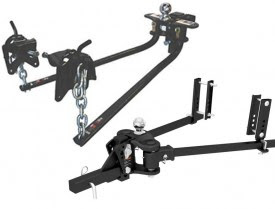Mastering Weight Distribution and Sway Control for Safe Towing
Towing a trailer or caravan can unlock a world of possibilities, whether for work or leisure. Yet, with the added weight behind your vehicle comes the responsibility of ensuring safe and stable towing. Two critical aspects of towing safety are weight distribution and sway control. In this comprehensive guide, we delve into these concepts, exploring their importance, how they affect towing performance, and practical tips to master them.
Understanding Weight Distribution
Weight distribution refers to how the load is distributed between
the towing vehicle and the trailer it's pulling. Proper weight distribution is
vital for several reasons:
- Balance and Stability: Evenly distributing weight ensures the towing setup
remains stable and balanced on the road. An imbalanced load can lead to
swaying or fishtailing, especially at higher speeds or in windy
conditions.
- Towing Capacity: Exceeding the vehicle's towing capacity or having an
uneven load distribution can strain the vehicle's suspension, brakes, and
engine, compromising safety and performance.
- Steering and Braking: Proper weight distribution allows the towing vehicle's
steering and braking systems to operate effectively under the additional
load.
To achieve optimal weight distribution:
- Use a Weight Distribution Hitch
(WDH): A WDH is a specialized towing
accessory designed to redistribute the trailer's tongue weight across the
towing vehicle's axles, leveling the setup and improving stability.
- Load Cargo Properly: Distribute cargo evenly inside the trailer, placing
heavier items low and towards the front to keep the center of gravity low
and balanced.
- Check Towing Capacity: Ensure the total weight of the loaded trailer
(including cargo) does not exceed the towing capacity specified by the
vehicle manufacturer.
Exploring Sway Control
Sway, also known as fishtailing, occurs when the trailer
oscillates side-to-side behind the towing vehicle. This can be dangerous and
challenging to control, especially in adverse conditions. Common causes of
trailer sway include:
- Crosswinds or Passing Vehicles:
Strong crosswinds or vehicles
passing closely can create turbulence, inducing trailer sway.
- Improper Weight Distribution: Unevenly distributed weight can cause the trailer to
sway when weight shifts during acceleration, braking, or cornering.
- Driving Speed: Excessive speed, especially around curves or in windy
conditions, can exacerbate trailer sway.
To manage sway effectively:
- Use Sway Control Devices: Install sway control devices like sway bars or
friction-based sway controls, which help dampen and minimize trailer sway.
- Properly Load the Trailer: Ensure the trailer is loaded evenly and within its
weight capacity to prevent sway caused by shifting cargo.
- Drive Safely: Maintain a moderate and consistent speed, avoid sudden
maneuvers, and use appropriate braking techniques to minimize sway.
Tips for Safe Towing
To enhance towing safety and minimize weight distributing and sway control issues, follow these practical tips:
- Regular Maintenance: Keep your towing vehicle and trailer well-maintained,
including tires, brakes, suspension, and hitch components.
- Practice Safe Driving Habits: Avoid sudden steering, braking, or acceleration
maneuvers that can induce sway.
- Invest in Quality Equipment: To optimize towing performance, use reputable towing
accessories such as weight distribution hitches and sway control devices.
- Know Your Limits: Adhere to recommended weight capacities and towing
guidelines specified by the vehicle and trailer manufacturers.
Safeguarding Your Towing Experience with Effective Weight
Distribution and Sway Control
In conclusion, mastering weight distribution and sway control
is essential for safe and confident towing. Proper weight distribution ensures
balanced load distribution and optimal vehicle performance, while effective
sway control techniques minimize the risk of trailer sway and enhance towing
stability. By understanding these concepts and implementing practical tips,
drivers can mitigate potential risks associated with towing and enjoy smooth,
safe travels with trailers or caravans. Remember, safety should always be the
top priority when towing, so take the necessary steps to ensure a secure towing
experience on the road.

.jpg)

Comments
Post a Comment